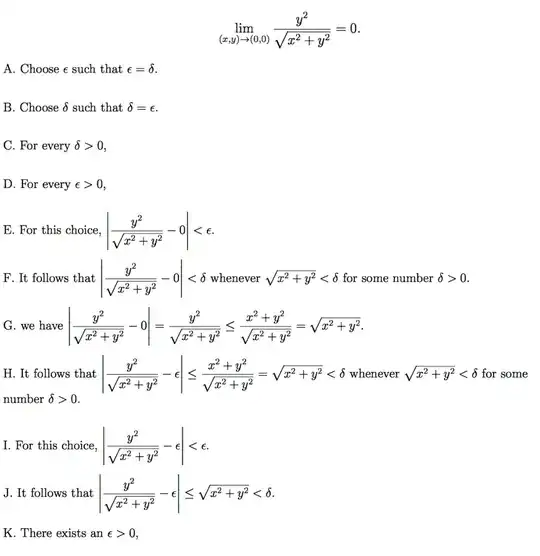Labelled below from A to K are the steps that show (5 steps) (sorry it is a picture and not written in latex)

I picked the following:D,C,F,G,B I was wondering if that is correct or if there is another way.
Labelled below from A to K are the steps that show (5 steps) (sorry it is a picture and not written in latex)

I picked the following:D,C,F,G,B I was wondering if that is correct or if there is another way.
The only sequence of steps that's both mathematically and grammatically correct is D,G,F,B,E in that order.
D.
For every $\epsilon>0$,
G.
we have $\left|\frac{y^2}{\sqrt{x^2+y^2}}-0\right| = \frac{y^2}{\sqrt{x^2+y^2}} \le \frac{x^2+y^2}{\sqrt{x^2+y^2}} = \sqrt{x^2+y^2}$.
F.
It follows that $\left|\frac{y^2}{\sqrt{x^2+y^2}}-0\right| < \delta$ whenever $\sqrt{x^2+y^2} < \delta$ for some number $\delta>0$.
B.
Choose $\delta$ such that $\delta = \epsilon$.
E.
For this choice, $\left|\frac{y^2}{\sqrt{x^2+y^2}} - 0\right| < \epsilon$.
This is very nearly the same choice of steps you have, except that:
I wouldn't call either of these serious omissions; this problem requires some amount of reading the author's mind to figure out what the steps are intended to mean out of context.
There's a lot of freedom in how to order these steps. Mathematically, I want to put G before F: the logic here is that we prove $A \le B$ (this is in step G), and therefore $A < \delta$ whenever $B < \delta$ (this is in step F). This is also the only aspect of the order where we disagree.
My other reasons for ordering these steps are non-mathematical (and wouldn't apply if we got to pick the wording of the proof, the way we would if we were really writing it):
In an actual proof, it wouldn't be unreasonable to put the equivalent of step B as early as immediately after D, for example. But with this specific wording of the steps, doing so wouldn't make sense.